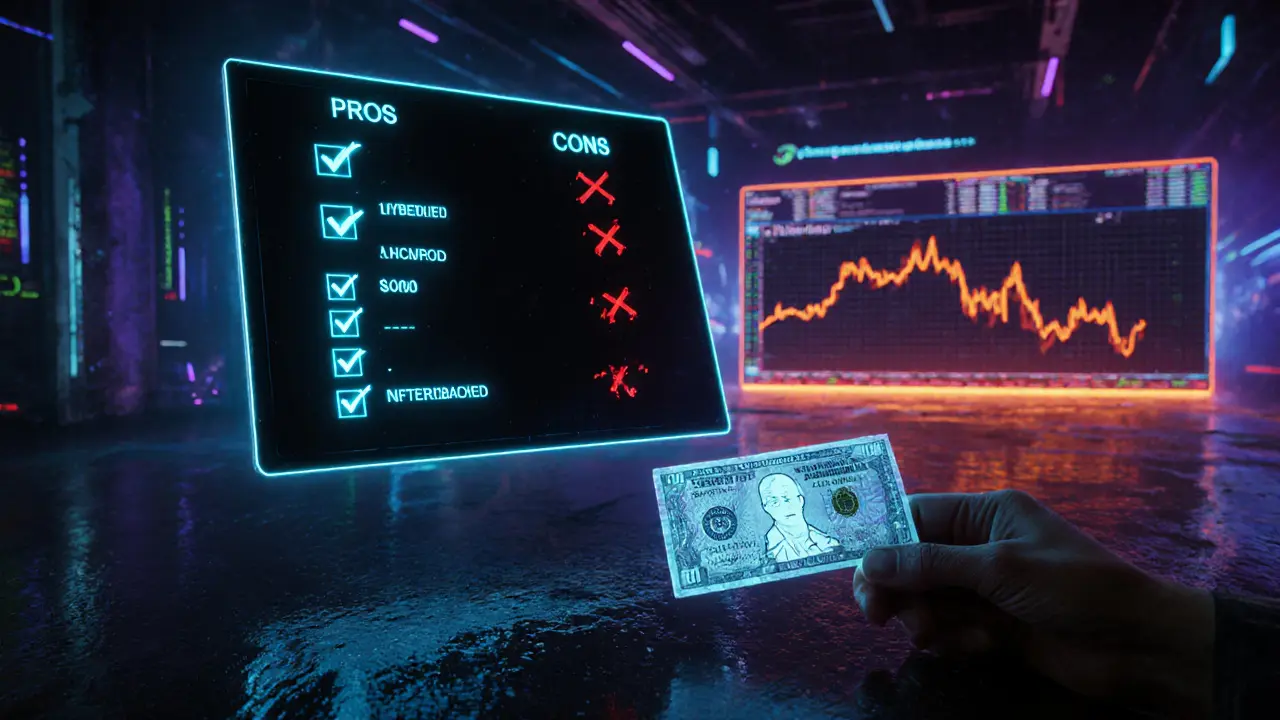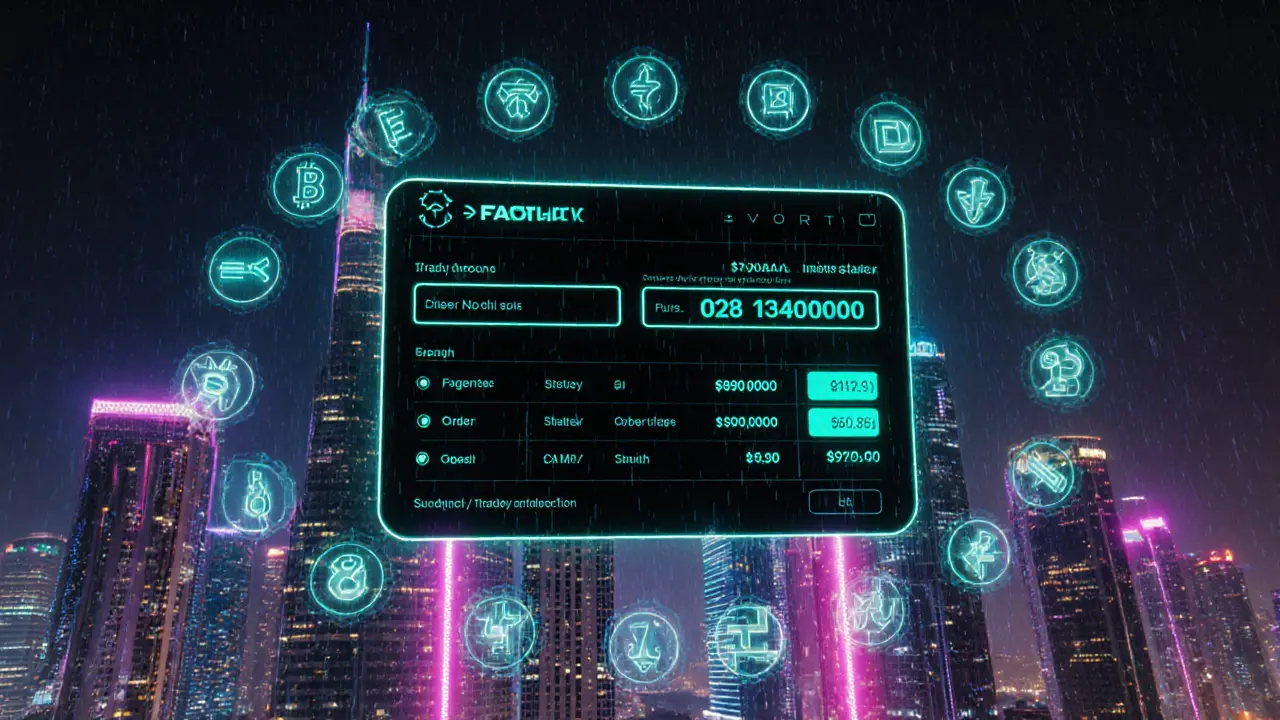Fastex Crypto Exchange Fee Calculator
Fee Calculation Result
Fastex Fee Details
- Maker Fee: 0.14%
- Taker Fee: 0.15%
- Deposit Fees: 0.09%-0.15% (varies by currency)
- Withdrawal Fees: No hidden fees
Note: All fees are displayed clearly before confirmation. Fastex does not charge hidden fees.
Fastex vs Major Exchanges (2025)
| Feature | Fastex | Binance | Coinbase | KuCoin |
|---|---|---|---|---|
| Spot Pairs | 49 | ≈350 | ≈200 | ≈400 |
| Maker Fee | 0.14% | 0.10%-0.02% | 0.50%-0.00% | 0.10%-0.02% |
| Taker Fee | 0.15% | 0.10%-0.04% | 0.50%-0.00% | 0.10%-0.05% |
| Web3 Ecosystem | FTN, ftNFT, Fastex Verse, YoWallet | BSC, BNB | Coinbase Wallet, USDC | KCC, KCS |
Fastex is a Dubai‑based cryptocurrency exchange launched in 2017 and powered by SoftConstruct. It positions itself as a spot‑trading hub with a built‑in Web3 ecosystem, including its native FTN token, an NFT marketplace, and a unified payment solution.
Quick Take
- Spot‑only trading, 49 crypto pairs, TradingView charts.
- Fees: 0.14%‑0.15% maker/taker, no hidden costs.
- Security: 2FA, cold storage, KYC for higher limits.
- Unique: FTN‑backed collectible notes and a unified wallet that links trading, NFTs and payments.
- Drawbacks: Limited coin selection, no margin or futures yet.
What Makes Fastex Different?
The platform bundles several services under one roof. Its ftNFT marketplace lets users buy and sell NFTs using the same wallet they trade with. Fastex Verse is the broader Web3 playground where developers can launch dApps that tap into the exchange’s liquidity. The newest addition, YoWallet, offers a standalone crypto wallet that syncs automatically with the exchange’s unified account.
Trading Features & Order Types
Fastex focuses exclusively on spot trading. Users can place:
- Market orders
- Limit orders
- Stop‑limit and stop‑market orders
- Trailing‑stop and trailing‑stop‑limit orders
The minimum order size is 0.1USDT, making it accessible for small‑scale traders. Advanced charting is powered by TradingView, so you get the same technical‑analysis tools you’d find on professional platforms.
Fee Structure - Transparent and Simple
Fees are flat and transparent:
- Maker fee: 0.14%
- Taker fee: 0.15%
- Deposit fees: 0.09‑0.15% (depending on currency)
- No hidden withdrawal fees - the exact amount appears before you confirm.
For comparison, major rivals charge between 0.08% and 0.20% but often hide extra fees for fiat deposits or withdrawals. Fastex’s all‑in‑one display helps you avoid surprise costs.

Security & Compliance
Security follows industry standards:
- Two‑factor authentication (2FA) required for login and withdrawals.
- Cold‑storage wallets hold the majority of user funds.
- KYC verification for higher withdrawal limits and access to the affiliate program.
- Regular security audits performed by third‑party firms (specific auditor names not disclosed publicly).
Customer support operates in multiple languages via live chat, email, and a ticket system. Response times range from a few hours for simple queries to up to 24hours for complex issues.
How Fastex Stacks Up Against the Big Players
| Feature | Fastex | Binance | Coinbase | KuCoin |
|---|---|---|---|---|
| Spot pairs | 49 | ≈350 | ≈200 | ≈400 |
| Leverage / Futures | None (planned 2026) | Up to 125× | None | Up to 100× |
| Maker fee | 0.14% | 0.10%‑0.02% | 0.50%‑0.00% | 0.10%‑0.02% |
| Taker fee | 0.15% | 0.10%‑0.04% | 0.50%‑0.00% | 0.10%‑0.05% |
| Fiat on‑ramps | Visa/Mastercard cards, several fiat currencies | Bank transfers, cards, dozens of fiat | Bank transfers, cards (limited regions) | Bank transfers, cards |
| Web3 ecosystem | FTN token, ftNFT, Fastex Verse, YoWallet | Binance Smart Chain, BNB token | Coinbase Wallet, USDC | KuCoin Community Chain, KCS token |
In short, Fastex shines on transparency, integrated Web3 tools, and a frictionless fee layout, but it trails on sheer coin variety and leverage options.
FTN‑Backed Collectible Notes - A Physical‑Digital Hybrid
July2025 saw Fastex launch limited‑edition paper notes that are 1:1 backed by the FTN token. Each note carries anti‑counterfeit features (serial numbers, intaglio ink, metallic foil) and is linked to a unique NFT. Holders can redeem the note for the same amount of FTN on the exchange at any time. This move bridges the gap between tangible collectibles and blockchain assets, giving traders a novel way to showcase ownership.
Pros & Cons Checklist
- Pros
- Clear, flat fee structure with no hidden charges.
- TradingView integration for professional charting.
- Unified wallet that connects trading, NFTs, and payments.
- Innovative FTN‑backed physical notes.
- Strong security (2FA, cold storage) and KYC for higher limits.
- Cons
- Limited to 49 spot pairs - fewer altcoins than major exchanges.
- No margin, futures, or leveraged tokens as of 2025.
- Occasional connectivity hiccups on Android during peak volume.
- Market share still small; liquidity can be lower for thinly‑traded pairs.
Final Verdict - Who Should Use Fastex?
If you’re a beginner or intermediate trader who values a clean UI, transparent fees, and wants to dip your toes into NFTs and a unified payment system, Fastex is a solid pick. Its Web3 ecosystem gives a glimpse of where exchanges might head in the next few years.
Advanced traders looking for deep liquidity, hundreds of altcoins, or high‑leverage derivatives will likely stick with Binance, KuCoin, or a specialized futures platform until Fastex rolls out its promised futures suite.
Overall, the platform feels more like a stepping‑stone toward a broader crypto‑finance hub rather than a one‑stop shop for all trading needs today.

Frequently Asked Questions
Is Fastex safe for storing large amounts of crypto?
Fastex uses industry‑standard security: two‑factor authentication, cold‑storage for the majority of funds, and regular third‑party audits. Large deposits are recommended to be kept partially in a personal hardware wallet for maximum safety.
Can I trade directly with the FTN token?
Yes. FTN is listed on the exchange and can be used to pay fees at a 10% discount. It also powers the collectible notes and can be swapped for other assets instantly.
What fiat currencies are supported for deposits?
Fastex accepts Visa and Mastercard deposits in EUR, USD, BRL, GEL, AMD, and a few other regional currencies. Deposits are processed instantly, and the exchange converts them to USDT for spot trading.
When will futures and leveraged tokens arrive?
The roadmap cites Q42025 for a beta futures launch, with full leveraged‑token support expected in early 2026. Keep an eye on official announcements for exact dates.
How do the FTN physical notes work?
Each note is printed with security features and minted as a unique NFT. The note can be redeemed on the exchange for the same amount of FTN tokens at any time, effectively acting as a paper‑backed cryptocurrency voucher.






Comments
11 Comments
Adarsh Menon
Wow, another exchange promising ‘no hidden fees’ – yeah right.
Laurie Kathiari
Reading this review feels like watching a salesman on a stage, promising the moon while the audience silently checks their wallets. The tone reeks of hype, and the so‑called “no hidden fees” claim is a classic bait‑and‑switch tactic. If you value transparency, you should demand a breakdown of how those maker and taker percentages translate on low‑volume trades. Don't be fooled by glossy tables that compare features without mentioning customer support latency. It's high time the community calls out exchanges that hide the real cost behind flashy UI. Honestly, anyone still considering Fastex without digging deeper is ignoring basic financial prudence.
Jim Griffiths
The fee structure is actually pretty straightforward – 0.14% maker and 0.15% taker. On a $1,000 trade you’d pay $1.40 or $1.50 respectively, which is modest compared to many rivals. Just remember the deposit fee varies by currency, so check the exact rate before moving funds. Also, keep an eye on withdrawal limits; while they claim no hidden fees, network fees still apply.
Matt Nguyen
One must question the underlying governance model of Fastex; the paucity of decentralized decision‑making raises red flags. The architecture appears to rely heavily on centralized order books, which could be susceptible to manipulation. Moreover, the Web3 ecosystem integrations listed-FTN, ftNFT-seem more like marketing jargon than substantive utility. It is prudent to scrutinize the code audit reports, which are conspicuously absent from their documentation. In my assessment, the exchange operates under a veneer of innovation while masking systemic vulnerabilities.
Taylor Gibbs
It's great you're looking into the fee details before diving in. The transparent display of maker and taker percentages is a solid starting point, especially for newcomers. If you ever feel overwhelmed, consider starting with a small test trade to see the real‑time costs in action. Also, joining community forums can provide firsthand experiences that complement the official info. Remember, a cautious approach often saves headaches later.
Rob Watts
Take the first step and set a modest trade limit you’re comfortable with. Watch the fee calculation in real time and let it guide your confidence. Small wins build the momentum you need to explore larger opportunities.
Bhagwat Sen
Dude, the comparison table is missing the crucial latency stats for order execution. You need to know how fast trades actually fill, otherwise you’re just guessing. Also, the claim of “no hidden fees” should be backed up by independent audits. If the exchange can’t prove that, it’s a red flag for sure.
Cathy Ruff
Seriously, anyone still buying into this “Fastex hype” is blind. The fees are mediocre at best and the so‑called Web3 suite is a joke. You’re better off sticking with proven platforms that actually respect users.
Amy Harrison
Hey everyone! 🌟 I think Fastex has some cool features that could be handy for beginners. The fee calculator looks user‑friendly, and the variety of spot pairs is decent for a start. If you give it a try, maybe share your experience so we can all learn together! 😊
Eva Lee
From a liquidity provisioning perspective, Fastex’s order book depth appears suboptimal when juxtaposed with tier‑1 exchanges. The spread compression mechanisms are not clearly delineated, which could impair arbitrage strategies. Additionally, the integration of ftNFT into the broader ecosystem lacks a robust API endpoint documentation, limiting developer interoperability.
stephanie lauman
Let me clarify a few misconceptions that permeate this discussion. First, the advertised maker fee of 0.14% does not account for hidden slippage that can arise under volatile market conditions. Second, the absence of a publicly audited smart contract audit signifies a potential security vulnerability that many overlook. Third, the claim of “no hidden fees” is a marketing platitude; network gas fees are invariably incurred on withdrawals. Finally, the platform’s alignment with regulatory frameworks remains ambiguous, raising compliance concerns that could affect user assets.
Write a comment